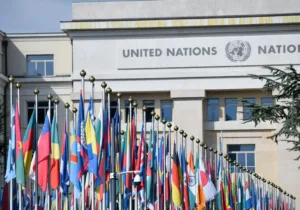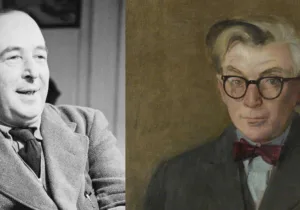Last month was the seventy-fifth anniversary of V-J Day—Victory over Japan, August 14, 1945—the official end of World War II. Yet most Britons prefer to celebrate V-E Day—Victory in Europe, May 8, 1945—the defeat of Nazi Germany. Why so? It’s partly because Britons, then and now, saw Hitler as their main existential threat, as indeed he was; and partly because the fighting with the Japanese in the spring and summer of 1945 is seen as little more than a series of mopping-up operations.
We have fallen victim, it seems, to one of the classic pitfalls of historical perspective: the benefit of hindsight. Because the war ended on August 14, we assume that a finish date in the summer of 1945 was more or less inevitable. It wasn’t. At the same time that American ground troops landed on the island of Okinawa, the most southerly of Japan’s prefectures, on April 1, 1945—the last staging post before an invasion of the Japanese home islands—British and Commonwealth troops were planning Operation Dracula, an air and sea attack on Rangoon, the capital of Burma. In the event, Dracula was a bloodless victory because, shortly before it was launched on May 2, 1945, the Japanese withdrew their defending forces.
With Rangoon and most of Burma in Allied hands, British commanders turned their thoughts to Malaya and the naval base of Singapore, the loss of which in February 1942, after a lightning Japanese advance down the Malay peninsula, had been the most humiliating British defeat of the war. The invasion of Malaya was planned in two stages: first a limited operation (codenamed Roger) to capture Phuket off the west coast of Siam; followed by a much larger invasion of Malay proper, Operation Zipper. This would enable Singapore to be recovered by the end of 1945.
Roger was canceled after members of a beach reconnaissance party—the forerunners to the modern SBS (Britain’s equivalent of US Navy SEALs)—were captured by the Japanese, thus compromising the whole operation. But that still left Zipper, the landing in the center of the Malay peninsula, which, if successful, would “draw a string round the middle of the bag; cut off the Japanese retreating southward from Burma and prevent northern advances and reinforcements from Singapore.”
Meanwhile, at Winston Churchill’s insistence, sizeable British and Commonwealth forces had been earmarked to support the United States’ campaign in the Pacific. During the invasion of Okinawa, for example, a small but significant part of the US Fifth Fleet’s sea and air assets were provided by the British Pacific Fleet (BPF). Comprised of four fleet carriers, two battleships, five cruisers (one each from New Zealand and Canada), 11 destroyers (two from Australia) and 220 aircraft, the BPF was the Royal Navy’s most formidable strike force of the war.
In mid-June, with the brutally-tough fight for Okinawa all but over—a three-month campaign that would eventually cost the lives of 250,000 servicemen and non-combatants—Churchill wrote to General George C. Marshall, the US Army chief of staff, offering to place 10 squadrons of planes on the island to “take part in the air bombardment of Japan.” The prime minister wrote later:
The Americans intended to seize Kyushu, the most westerly island of Japan, early in November 1945, and from there to invade the main island of Honshu. Here stood an army of more than a million men, well trained, well equipped, and fanatically determined to fight to the last. What remained of the Japanese Navy and Air Force was just as resolute. These two great operations would have entailed bitter fighting and great loss of life.
Less than a week after Churchill’s offer of the planes, President Harry Truman met with his senior political and military advisors in Washington, DC, to discuss Japan’s unconditional surrender. The only way to achieve this, said General Marshall, was to invade Japan’s home islands: Kyushu on November 1, 1945, and Honshu the following spring (two operations that were known collectively as Downfall). Casualties were impossible to estimate, said Marshall, but given the huge number of men lost on Okinawa, and the fact that the enemy would fight even more fanatically in defense of Japan proper, it would be a “terrifying, bloody ordeal” for the US servicemen involved.
Was there any alternative to a ground invasion? asked Truman. Yes, said Assistant Secretary of War John J. McCloy. To threaten to use the newly developed atomic bomb; and if the threat was ignored, to drop it on a Japanese city.
Truman was encouraged by this but said no decision could be taken until they knew the bomb would work. In the meantime, planning would continue for the invasion on November 1. But everything changed on July 16 when Truman received word in Berlin, where he was attending the inter-Allied Potsdam Conference with Churchill and Stalin, that the “first full scale test” of “the atomic fission bomb” in the New Mexico desert had been “successful beyond the most optimistic expectations.” The memo added: “We now had the means to ensure [the war’s] speedy conclusion and save thousands of American lives.”
On hearing of the successful test in New Mexico, Winston Churchill felt that the “nightmare picture” of an invasion of Japan—which might have cost a million American and 500,000 British lives—“had vanished” and “in its place was the vision, fair and bright it seemed, of the end of the whole war in one or two violent shocks”. This “almost supernatural weapon” would give the Japanese, he felt, “an excuse which would save their honour and release them from the obligation of being killed to the last fighting man.”
Soon after, Truman signed the final ultimatum to Japan known as the Potsdam Declaration. It called upon Japan to agree to immediate unconditional surrender or face “prompt and utter destruction.” When Tokyo ignored the ultimatum, Truman gave the order to drop an atom bomb on Hiroshima, “an Army city” and “major quartermaster depot” with warehouses full of military supplies.
Truman’s decision to authorize the use of the atomic bomb was directly influenced by the bloodbath on Okinawa. He feared that an invasion of Japan would look like “Okinawa from one end of Japan to the other,” and that it would cost the US military more than a million dead and wounded. It would also kill countless Japanese soldiers and civilians. “My object,” wrote Truman, “is to save as many American lives as possible but I also have a human feeling for the women and children of Japan.”
The first atomic bomb—“Little Boy”—was dropped by the US B-29 Superfortress Enola Gay on Hiroshima on August 6. A second bomb—“Fat Man”—exploded in Nagasaki three days later. The combined dead from the bombs were 200,000 Japanese, mostly civilians; an appalling total, but less than the number killed on Okinawa, and a fraction of those who would have died if the US had invaded mainland Japan. Such a desperate course of action was no longer necessary. Japan agreed to surrender unconditionally on August 14, much to the delight and relief of the Allied troops who were due to take part in Operations Zipper and Downfall.
If the bombs had not been used, the war might have dragged on for another year and cost the lives of hundreds of thousands of Allied servicemen. Winston Churchill, for one, was convinced that Truman had done the right thing. “The historic fact remains,” he wrote, “and must be judged in the after-time, that the decision whether or not to use the atomic bomb to compel the surrender of Japan was never an issue. There was unanimous, automatic, unquestioned agreement around our table; nor did I ever hear the slightest suggestion that we should do otherwise.”






 Sponsor a student for Christianity & National Security 2024
Sponsor a student for Christianity & National Security 2024